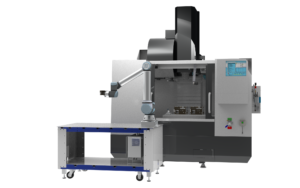no operation the size of wheelie or wrustle would have even considered such a scheme in say 1995....
Think about it , in the mid 80's a Bridgeport CNC knee mill was 40k then.
In the early 90s everyone had a 2 axis prototrak
Then Haas was making VMCs as cheap as old CNC knee mills
Honestly there is a number that robots make sense, but it is pretty high
I think I would push parts on the table before that automation.
More parts on the table means a longer cycle, fewer tool changes per part and makes the operator interaction with the machine denser.
But then you battle space, and talent shortages, and , and and....
I think these robots are cool as hell, but for me, I think, they would have to come pretty integrated with the machine. I would want that 10 minute changeover, because with fast machines, 100, 200 parts is a couple hours and on to the next slightly different thing, or priorities change...that's the power we have over offshore, ability to change quickly.
I think a brother speed machine with an integrated robot programmed simultaneously would be a very, very attractive thing for a smaller shop.
I don't know how you do that...but....
Then there is cost
Automation is cheaper than people, but you can lay off people if need be, but boy they get funny when you don't make that machine payment.
So, yes, I see it, I see in the future lots of shops like Wrustles but he made very specific decisions for his very specific work and it has to get a little more flexible and universal before every 5 man shop has 3 men and 2 robots....


